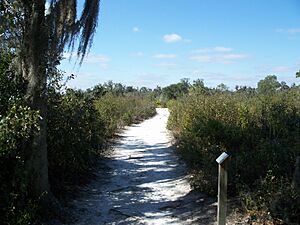Paynes Creek Historic State Park facts for kids
Quick facts for kids Paynes Creek Historic State Park |
|
|---|---|
 |
|
| Location | Hardee County, Florida, USA |
| Nearest city | Bowling Green, Florida |
| Governing body | Florida Department of Environmental Protection |
|
Payne's Creek Massacre--Fort Chokonikla Site
|
|
| Nearest city | Bowling Green, Florida |
| Area | 400 acres (161.9 ha) |
| Built | 1849 |
| NRHP reference No. | 78000944 |
| Added to NRHP | November 21, 1978 |
Paynes Creek Historic State Park is a special park in Florida. It is located near Bowling Green, Florida. This park helps us remember important events from the past. On November 21, 1978, it became a part of the National Register of Historic Places. It is known as the Payne's Creek Massacre-Fort Chokonikla Site.
Contents
Exploring the Park's History
Life After the Seminole Wars
After the Seminole Wars, agreements called treaties were made. These treaties set aside land for the Seminole people in Florida. But after the Second Seminole War, a new law was passed. It was called the Armed Occupation Act of 1842. This law allowed new settlers to claim land in Florida.
Many settlers started moving onto the Seminole lands. This happened even though the treaties said they shouldn't. Seminole leaders like Billy Bowlegs were worried about these new neighbors.
The government also limited what the Seminoles could trade. This was to stop them from getting weapons. So, trading stores run by white settlers were allowed near the Seminole lands. These stores let the Seminoles buy things they needed.
The Trading Post Attack of 1849
One of these trading posts was built in 1849. It was located near what is now Bowling Green, Florida. The owners were Captain George Payne and Dempsey Whidden.
On July 17, 1849, a sad event happened. Captain Payne and Dempsey Whidden were killed. William McCullough and Nancy McCullough were also hurt. This attack was carried out by a small group of Seminoles. After the attack, the trading post was burned down. A similar attack had happened a few days earlier near Fort Pierce, Florida.
Building Fort Chokonikla
The attack on the trading post made many settlers scared. They fled to nearby safe places. They asked the army for help to return home.
Because of this, Fort Chokonikla was built. It was set up on October 26, 1849. This was only three months after the trading post attack. The fort was built near where the trading post had stood. Its name, "Chokonikla," likely means "burnt store" in the Seminole language.
After the fort was built, the nearby creek got a new name. It became known as Payne's Creek. We still call it that today.
However, the fort was built near a swamp. This area had many mosquitos. Many soldiers at the fort became sick with malaria. The fort's doctor suggested closing it. The army agreed quickly. The fort was left empty on July 18, 1850. It had been open for less than nine months.
Fun Things to Do at the Park
Paynes Creek Historic State Park offers many activities. You can go canoeing or kayaking on the water. It's also a great spot for fishing. If you like treasure hunts, you can try geocaching. Many people enjoy watching birds and butterflies here too.
The park has several historic sites to explore. There are also three picnic areas for families and friends. A museum at the visitor center shows what pioneer life was like long ago.
Park Hours
Florida state parks are open every day of the year. You can visit between 8 AM and sundown. This includes holidays!





